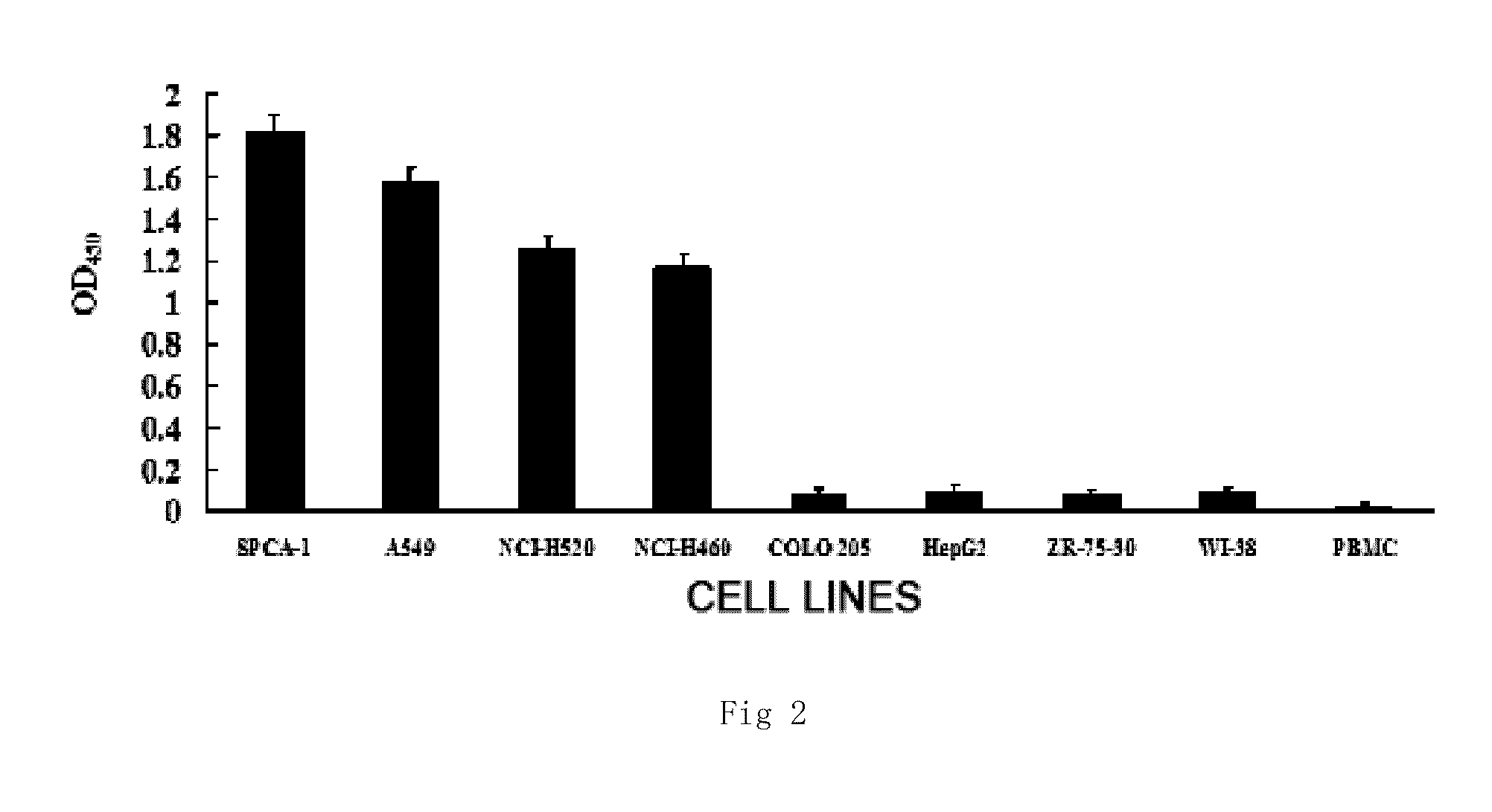Monoclonal antibody against human non-small cell lung carcinoma and use thereof
a lung cancer and monoclonal antibody technology, applied in the field of biotechnology, can solve the problems of poor treatment effect of patients, unsatisfactory traditional treatment methods for lung cancer, and poor therapeutic effect of chemotherapy for quite a number of patients, and achieves high yield, specific reactivity, and high titer
- Summary
- Abstract
- Description
- Claims
- Application Information
AI Technical Summary
Benefits of technology
Problems solved by technology
Method used
Image
Examples
embodiment 1
[0045]Obtainment of Hybridomas
[0046]1.1. Animal Immunization
[0047]Female BALB / c mice, 6 to 8 weeks old, are prepared and then abdominally injected for the purpose of immunization for four times with 2×106 SPCA1 cells injected each time, once every 3 weeks. Blood is collected from the inner canthus of the mice before each immunization, and the titer of the serum antibody of the mice is detected by indirect cell ELISA. Mice splenocytes are prepared for fusion when the titer of the serum antibody of the immunized mice reaches the maximum value and will not rise any more, and the mice splenocytes will be immunized once 3 days before fusion.
[0048]1.2. Indirect Cell ELISA Tests
[0049]SPCA1 cells are inoculated on a 96-well plate with 2×105 cells for each well until the cell growth reaches 80% fusion, fixed with 95% ethanol, washed with PBS for 3 times, soaked in 0.2% Triton-X-100 for 20 min, and then sealed with 50 g / L of BSA at 37° C. for 2 h, sequentially added with 100 μL of immunized m...
embodiment 2
[0052]Preparation and Purification of Monoclonal Antibody Ascites
[0053]Female BALB / c mice, 8 to 10 weeks old, are prepared and then abdominally injected with 0.5 mL of paraffin oil, and after 10 days, abdominally injected with well-grown hybridoma cells NM001-1 and NM001-2, about 1×106 hybridoma cells for each mouse, respectively. Ascites is pumped after 1 to 2 weeks. The ascites is risen to 37° C. for 1 h and then kept overnight at 4° C.; and, centrifuged the next day, and purified by Protein G affinity chromatography to obtain the purified monoclonal antibodies NJ001-1 and NJ001-2.
embodiment 3
[0054]Identification of Monoclonal Antibodies
[0055]3.1 Identification of Subclass of Monoclonal Antibodies Ig
[0056]The purified monoclonal antibodies are diluted with PBS in a rate of 1:10000 in accordance with Instructions of Assay Kit. The subclasses of the monoclonal antibodies NJ001-1 and NJ001-2 are IgG, and the light chain is K chain.
[0057]3.2 Measurement of Titer of Monoclonal Antibodies
[0058]The purified monoclonal antibodies NJ001-1 and NJ001-2 are diluted in multiple proportion with PBS, respectively, and 100 μL of the diluted solution is measured and added to a 96-well plate coated with SPCA1 cells, the optical density (OD) is measured by indirect cell ELISA, and the maximum dilution of the monoclonal antibodies which may have immune response to the coating cells is regarded as the titer. The titer of the monoclonal antibody NJ001-1 is 4×106, and the titer of the monoclonal antibody NJ001-2 is 1.6×106. The hybridoma cell strain NM001-1 is deposited in China Center for Typ...
PUM
| Property | Measurement | Unit |
|---|---|---|
| temperature | aaaaa | aaaaa |
| concentrations | aaaaa | aaaaa |
| temperature | aaaaa | aaaaa |
Abstract
Description
Claims
Application Information
 Login to View More
Login to View More - R&D
- Intellectual Property
- Life Sciences
- Materials
- Tech Scout
- Unparalleled Data Quality
- Higher Quality Content
- 60% Fewer Hallucinations
Browse by: Latest US Patents, China's latest patents, Technical Efficacy Thesaurus, Application Domain, Technology Topic, Popular Technical Reports.
© 2025 PatSnap. All rights reserved.Legal|Privacy policy|Modern Slavery Act Transparency Statement|Sitemap|About US| Contact US: help@patsnap.com



